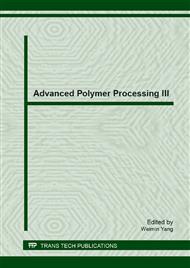p.113
p.119
p.125
p.130
p.135
p.141
p.146
p.152
p.158
Research on the Preparation of the Low Density Material with High Volume Filling Rate of Phenolic Hollow Microsphere
Abstract:
In this paper, an experimental mixing equipment has been developed for producing low density material with a high volume filling rate of phenolic hollow microsphere. The experiments with the equipment aim to explore the feasibility of this equipment for industrial production and to optimize the process. Experiments have been made to evaluate the influence of the filling ratio and the mixing rotor movement on the mixing effect. The results show that when the volume filling ratio of the material to the mixing barrel is about 40% the mixing effect is the best. But with mixing time increasing, the broken ratio of hollow microsphere will increase too. To solve this problem, some changes on the rotor movement have been made. The results show that the broken ratio increasing rate becomes lower and the density becomes more uniform. These indicate that the broken ratio can be well controlled by a suitable production process.
Info:
Periodical:
Pages:
135-140
Citation:
Online since:
July 2013
Authors:
Price:
Сopyright:
© 2013 Trans Tech Publications Ltd. All Rights Reserved
Share:
Citation:


